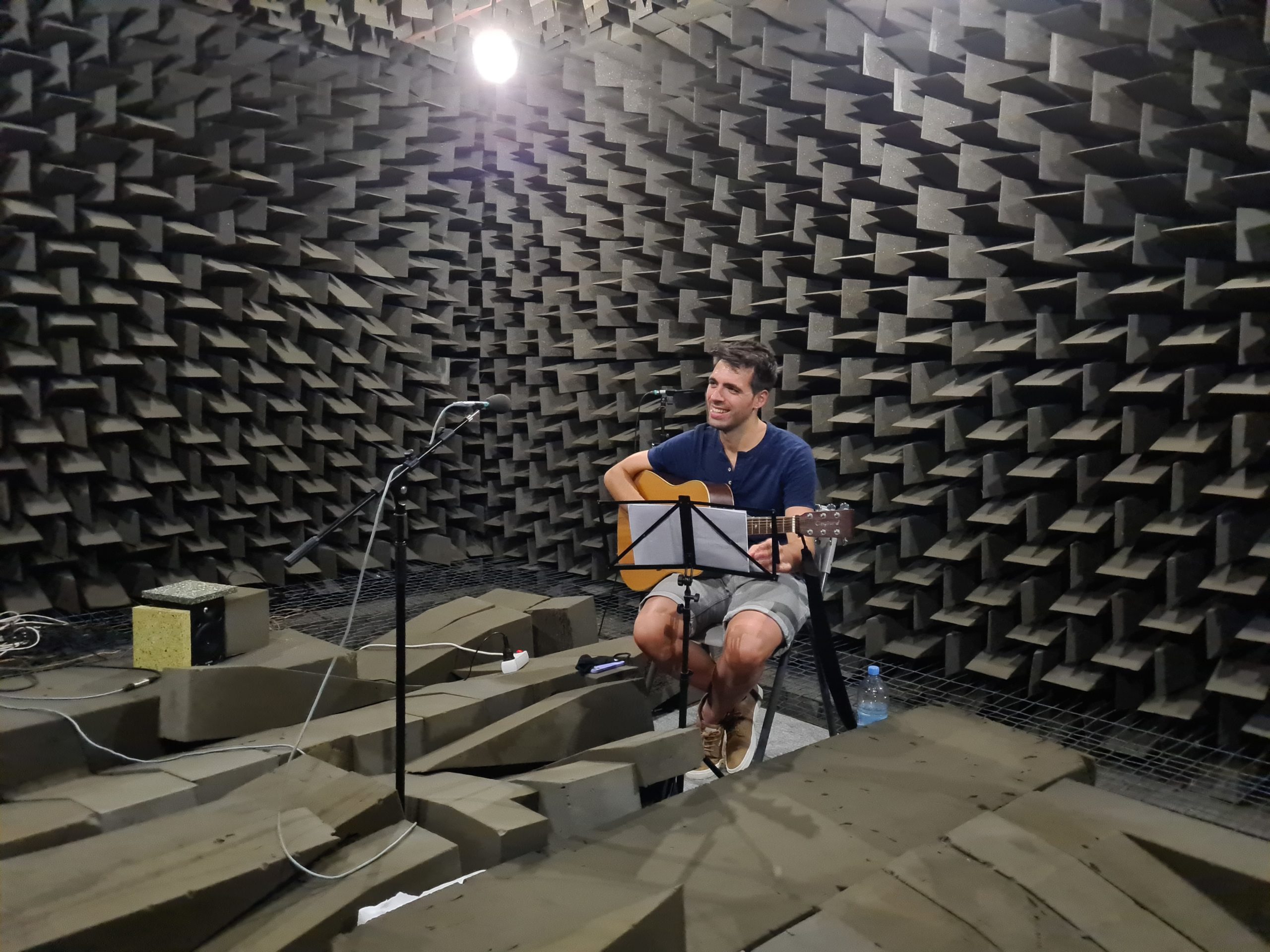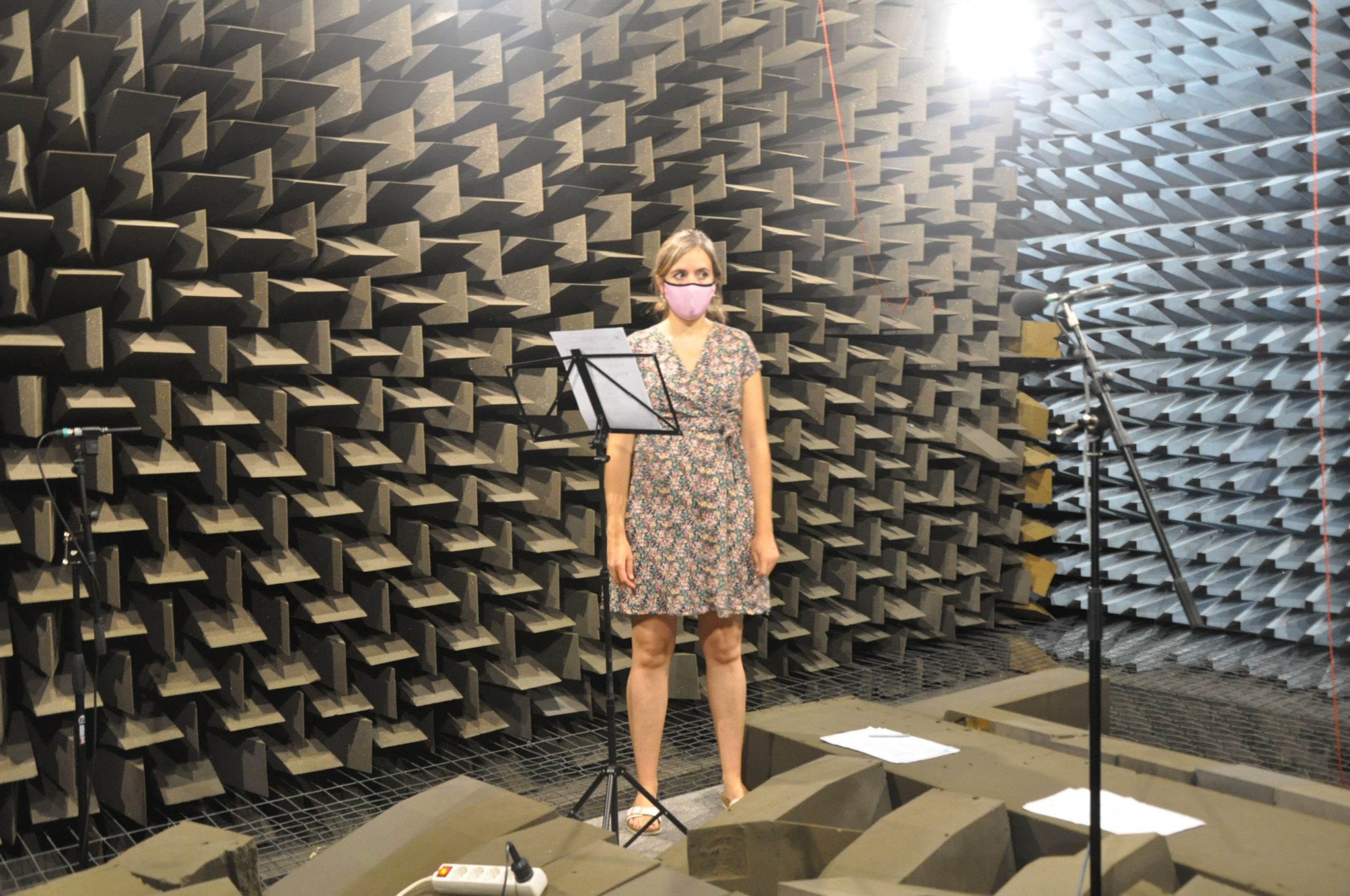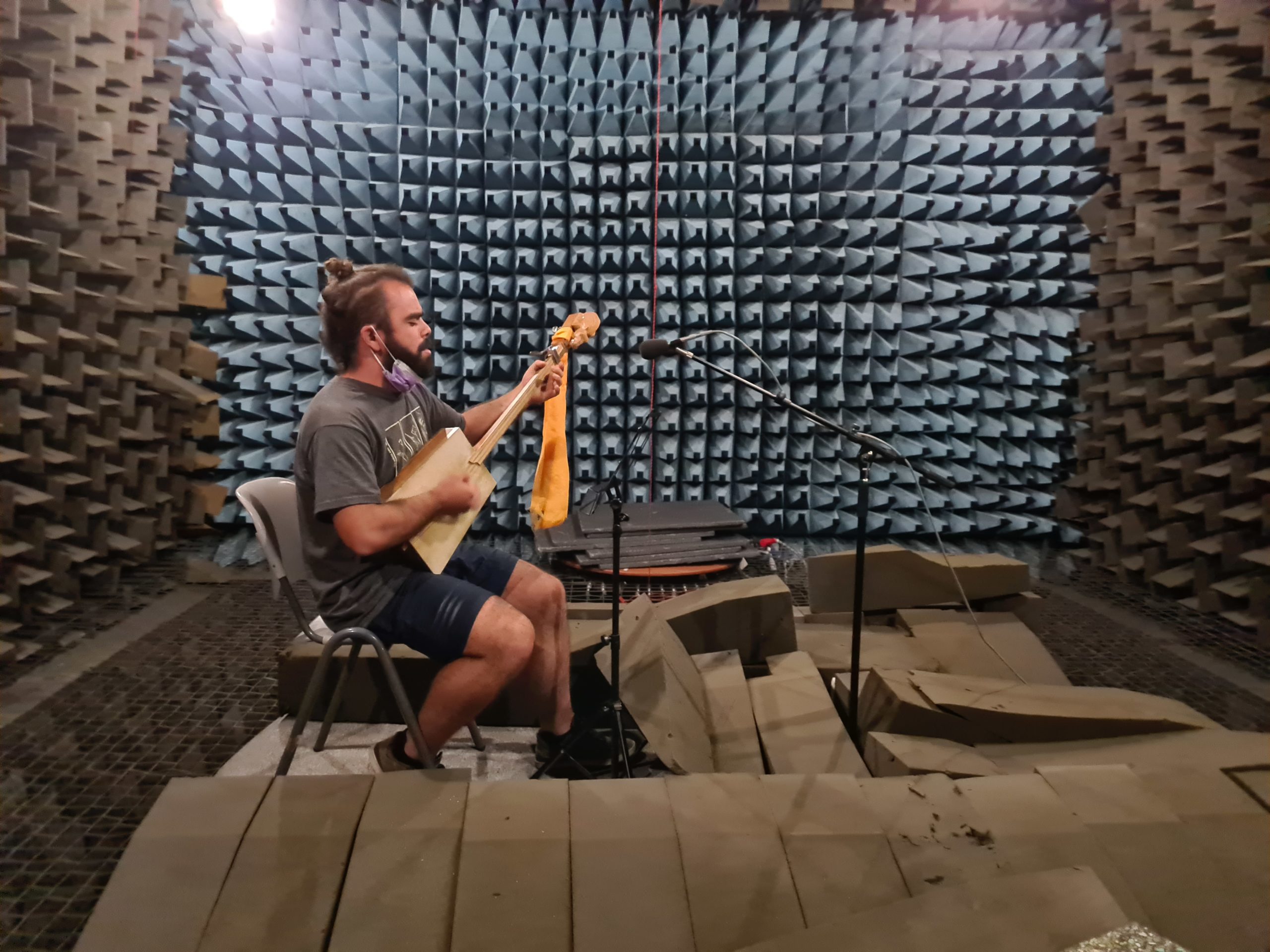By Samantha López-Mochales, PhD Candidate, and Raquel Jiménez-Pasalodos, Research Collaborator
Last July, members of the Artsoundscapes psychoacoustics, neuropsychology and ethnomusicology research groups worked together on making a series of high-quality musical recordings. The objective was to create a library of music and sounds to be used by all the Artsoundscapes project research lines. In the future we are planning to use them for dissemination activities, as well as for psychoacoustics and neuropsychology experiments. They are not conventional studio recordings, as they are completely dry stimuli recorded in an anechoic chamber. If you want to know what an anechoic chamber is and why we recorded in it, keep reading.
Auralization
As we saw in previous blog entries, the psychoacoustic experiments undertaken in the Artsoundscapes project use a process known as ‘auralization’. Auralization means simulating the experience of acoustic phenomena rendered as a soundfield in a virtualised space. In other words, it aims to present an entire soundscape in an artificial environment under lab conditions. Our laboratory – the immpaLAB – consists of a 16-channel 3D loudspeaker array. Using auralization we can, for example, reproduce highly accurately the sounds of the forest as if we were in the forest itself, or the sound of a choir singing in a cathedral as if we were present. Using this technique combined with behavioural research methods we can measure individual reactions and the subjective interpretations listeners attribute to sound, as well as the affective responses the sound evokes in them.
In the Artsoundscapes project we use the impulse responses recorded in our archaeological fieldwork campaigns. The impulse response is a measure of the sound propagation between an emission point and a receiver device located in the same environment (Farina et al., 2007) and represents the acoustic signature of a space (Vörlander, 2008). When we characterise the acoustics of a rock art site, these data serve, through auralization, to reproduce any given sound as played at the rock art site.
For our experiments involving auralization, we are interested in rendering any sound of our choice with the acoustics from the sites of archaeological interest recorded during our fieldwork campaigns. Therefore, we wanted to create our own library of sounds, especially sounds that may be relevant to different rock art areas and chronologies, such as those from archaeological instruments, as well as contemporary ethnographic music. To render a sound with the acoustics of a particular space we use the ‘convolution’ technique that allows us to listen to, for example, an elephant trumpet as if it were inside a cave, or someone singing ‘Happy Birthday’ as if they were in some isolated corner of Siberian Altai. But what is a ‘convolution’?
Convolution is the union between a sound and an impulse response. In order to accurately represent how that stimulus would sound in the place where the impulse response was recorded, the sound needs to be dry. This means it cannot contain any acoustic information about the space where it was recorded. If I were to take my smartphone right now and record myself singing ‘Happy Birthday’, this could not be used for convolution because, apart from the poor sound quality of the recording, I would also have recorded all the sound reflections (or ‘reverberation’) of my room. Recording studios have better sound treatment and less reverberation than most conventional rooms, but still have some reflections. Therefore, for our auralizations we needed a library of completely dry sounds. Anechoic chambers allow you to record this kind of sound. Now… what is an anechoic chamber?
The Anechoic Chamber
An anechoic chamber (Figure 1) is a room designed to completely absorb the reflections of either sound or electromagnetic waves. These rooms are generally used for acoustic experiments in “free field” conditions. In a true “free field” there are no walls that can reflect signals of any kind, all sound energy travels away from the source without any being reflected back.

Figure 1. The anechoic Chamber at the La Salle Acoustics Laboratory (Ramon Llull University, Barcelona, Spain).
Anechoic chambers use a series of foam wedges that absorb the sound waves impacting the walls, avoiding their reflection back to the source. The wedges also isolate the room to prevent sound from inside escaping and sound from outside entering. The shape of the wedges is key, as the sound the foam does not absorb in the first place and is reflected, bounces up and down in the gaps between the wedges, and every time it bounces, it is further absorbed by the foam. This means the number of reflections that escape the structure is minimal (Figure 2).

Figure 2. Minimisation of the reflection of sound waves by an anechoic chamber’s walls (from Wikipedia, article “Anechoic chamber”, user Estebandgj).
Recording in the anechoic chamber: the music, the musicians, the instruments, etc.
Our recordings were conducted in the anechoic chamber at the La Salle acoustics laboratory (Ramon Llull University, Barcelona (Fig. 1). This room, with a volume of 213 m3 , is the largest anechoic chamber in Barcelona and one of the largest in Spain. It is not only covered by foam wedges for the absorption of sound reflections, but is also electromagnetically isolated from the outside by a layer of copper covering the walls underneath the acoustic foam. Furthermore, a series of vibration isolators prevent any structural noise from the building that could interfere with the experiments performed in the room. Dr Marc Arnela and his team of sound and acoustics engineers hosted us for a couple of days last July to help us fulfil our objective.
What kind of music did we record? First, we recorded songs to be used in the psychoacoustical experiments in which we were attempting to ascertain whether certain acoustical characteristics, regardless of the musical style, were able to trigger certain emotions in listeners. To enable the triggering of emotion we needed to use music that was relevant to the individuals who were going to participate in the experiment. Thus, before recording we designed a musical preference poll. As a result, we realised we needed a series of anechoic recordings of rock and pop songs. We then contacted singers María Illa and Julen Gerrikabeitia, who recorded well known songs in the anechoic chamber. It was important for us to have both female and male voices. Furthermore, we also wanted to record music that was not so relevant to today’s audiences, both in the form of Catalan traditional music and other foreign traditions, such as Altaian traditional music. In order to do so, we also had Guillem Codern on board, a Catalan musician who is well versed in traditional Tuvan music, such as khoomei and other vocal styles, as well as several Tuvan string instruments.

Figure 3. Julen Gerrikabeitia (singer and guitarist) in the anechoic chamber.

Figure 4. Maria Illa Costa (singer) in the anechoic chamber.
For the neurological experiments to be undertaken in the Artsoundscapes project we also needed recordings that would stimulate a brain response linked to altered states of consciousness. Instead of using digitally made sounds, we recorded diverse membranophones used in various shamanic traditions in the Circumpolar area and America. We asked Venezuelan musician and instrument maker, Yonder Rodriguez, to play the different drums at certain tempos that are usually used in trance rituals all over the world. The anechoic recordings obtained will allow us to use them both in experiments that do not need them to be convoluted or, alternatively, convoluted with the different acoustics being measured in the project in various rock art landscapes around the world.

Figure 5. Yonder Rodríguez (musician) playing a replica of a historical Sámi drum in the anechoic chamber.

Figure 6. Guillem Codern (musician) playing a Tuvan doshpuluur in the anechoic chamber.
In addition to recording music for the psychoacoustical and neurological experiments, our third objective in recording music in this way was to create a good anechoic library to be used in the design of further experiments and to implement dissemination strategies, such as future virtual reality environments and virtual recreations. A project studying acoustics often needs sound examples to illustrate some of the research activities, measurements, and questions. There are currently no anechoic libraries available with the sounds of reconstructed archaeological musical instruments or hunter-gatherer instruments. This meant we had to create a project-specific anechoic library. Moreover, although anechoic sounds can sometimes be obtained online, they are not free of rights and their use presents problems. Thus, for our project, Venezuelan musician Yonder Rodriguez played several reconstructions of archaeological instruments, such as Palaeolithic bone pipes, whistles and bullroarers, diverse kinds of rattles and scrapers, and traditional and shamanic Amazonian instruments.
What does an anechoic song sound like and how does it sound once it is convoluted?
- Homudal, koomei and igil (Guillem Codern) convolved with the impulse response from the rocky cliff of Adyrkan in the Chuya Valley.
Homudal, koomei and igil
2. Afro-Venezuelan flute chimbangle (Yonder Rodríguez) convolved with the impulse response from the rocky flattened hill of Kalbak-Tash 1, on the right bank of the Chuya River.
Afro-Venezuelan flute chimbangle
3. Maria Illa Costa humming ‘La Dama d’Aragó’ (traditional Catalan song) convolved with the impulse response from the rock art site of ‘Roca Roja’ (Catalonia).
‘La Dama d’Aragó’
References
Farina, A., Capra, A., Conti, L., Matignon, P., & Fazi, F. (2007). Measuring Spatial Impulse Responses in Concert Halls and Opera Houses Employing a Spherical Microphone Array. 19th INTERNATIONAL CONGRESS ON ACOUSTICS, (September), 2–7.
Vorländer, M. (2008). Auralization. Berlin: Springer.
